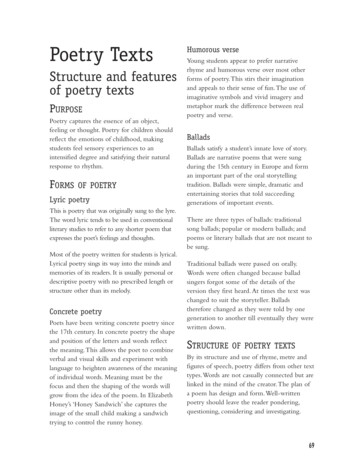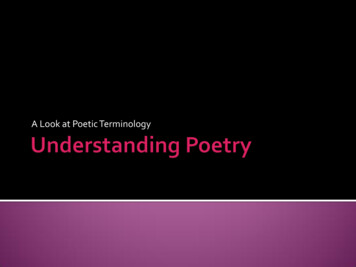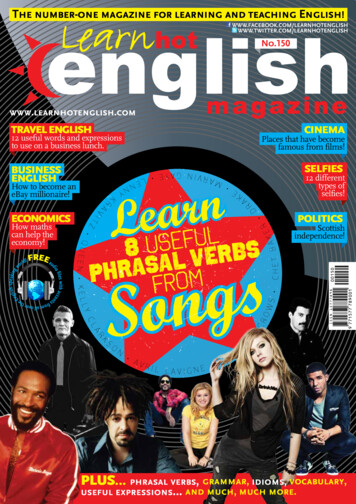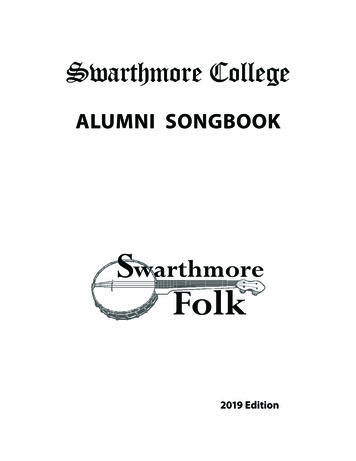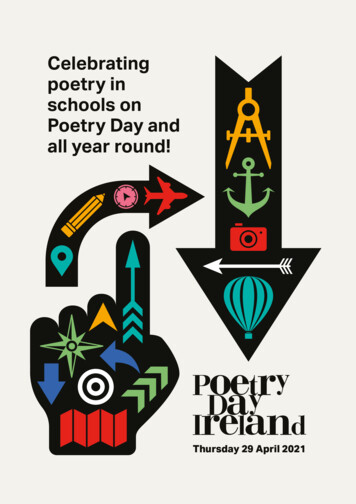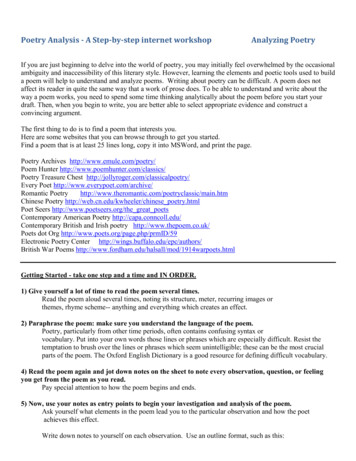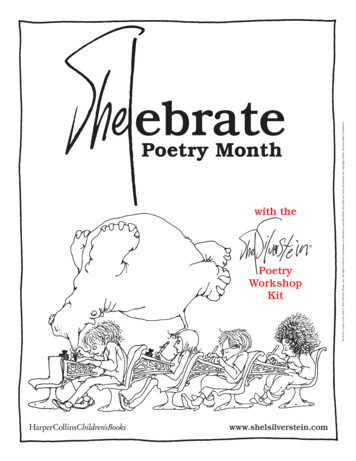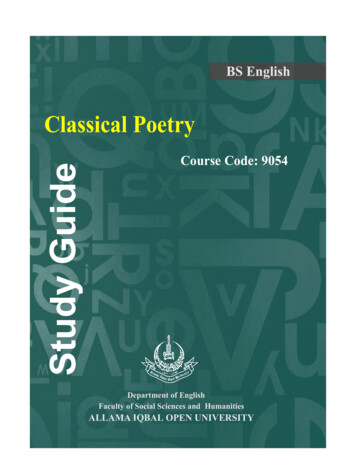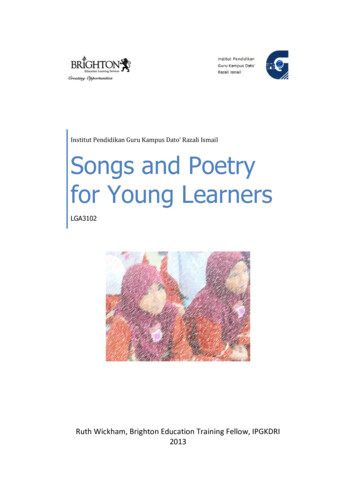
Transcription
Institut Pendidikan Guru Kampus Dato’ Razali IsmailSongs and Poetryfor Young LearnersLGA3102Ruth Wickham, Brighton Education Training Fellow, IPGKDRI2013
LGA3102 Songs and Poetry for Young LearnersContentsIntroduction . 3Objectives . 3Materials . 3Weekly Timetable . 3Topic 1: Overview . 4The Difference between Songs and Poetry. 4The Roles of Songs and Poetry in the Primary ESL Classroom . 9References used in Topic 1 . 9Topic 2: Songs and poetry for young learners . 101. Genres of Poetry . 10Forms of Poetry . 122. Genres of Songs . 17References used in Topic 2 . 20Topic 3: Pedagogical principles of teaching songs and poetry to young learners . 22Workshop: Songs and Poetry for Young Learners . 24References used in Topic 3 . 27Topic 4: Purposes of using songs and poetry in the Malaysian primary school . 28Reasons for using songs in the ESL/EFL classroom . 28What can songs and poetry offer? . 32References Used in Topic 4 . 33Topic 5: Linking poetry and songs to dimensions in the Malaysian primary ESL curriculum . 34Content and Learning Standards . 36Modular Curriculum, World Themes, and Educational Emphases . 39Using the Primary School Text Book . 41References used in Topic 5: . 44Topic 6: Principles of selection and adaptation of songs and poems . 45Criteria for text selection . 45Characteristics of poems and songs that children prefer . 47Topic 7: Activities and materials to encourage aesthetic development through songs and poetry. 48What is it that attracts children to songs and poems? . 481Ruth Wickham, Brighton Education Training Fellow, IPGKDRI
LGA3102 Songs and Poetry for Young LearnersAesthetic Response. 49Adapting activities and materials for different levels. 51Familiar Melodies for Improvising . 52References Used in Topic 7 . 53Topic 8: Language development through songs and poetry . 54Creating and using chants . 54What are the advantages of using Jazz Chants?. 54Shouting in the Classroom . 55A Song as a Text . 56Create a Vocabulary Chant. 58Jazz Chants for Grammar . 59References Used in Topic 8 . 62Topic 9: Planning ESL lessons using songs and poetry . 62Creating a Songs and Poetry Teaching Pack . 62Topic 10: Simulated teaching . 65Simulated Teaching: Reflection and Feedback . 65Appendix 1: Songs and Poetry Workshop . 66Appendix 2: Creating Songs and Chants . 78Appendix 3: Songs included in KSSR Year 1, 2, and 3 Text Books. . 992Ruth Wickham, Brighton Education Training Fellow, IPGKDRI
LGA3102 Songs and Poetry for Young LearnersSongs and Poetry for Young LearnersIntroductionThis module has been prepared in collaboration with the lecturers presenting this course insemester 1, 2013, at IPGKDRI.The Course Proforma states that ‘this course focuses on an overview of children’s literature, songsand poetry for young learners, pedagogical principles of teaching songs and poetry to younglearners, purposes of using songs and poetry in the Malaysian primary school, principles of selectionand adaptation of songs and poems, activities and materials to encourage aesthetic developmentthrough songs and poetry, language development through songs and poetry, planning ESL lessonsusing songs and poetry, simulated teaching, reflection and feedback.’ObjectivesThese are the Learning Outcomes as stated in the Course Proforma:1. Demonstrate an understanding of the characteristics of songs and poetry and their values in theprimary ESL classroom (1.1, 1.5)2. Select and evaluate songs and poetry for use in the primary ESL classroom based on pedagogicalprinciples (3.3, 3.6, 6.3, 6.6)3. Adapt activities and materials for use in the primary ESL classroom for language and aestheticdevelopment (6.1, 6.2, 7.1)4. Plan and implement ESL lessons using songs and poetry (8.4, 7.2, 2.4)MaterialsThe lecturer needs this module and also the module of students notes. The students’ module can beprinted out and handed out piece by piece as needed, or as a complete module at the start.This symbol indicates that there is a worksheet for the students to work on.This symbol indicates a discussion topic for pairs or groups.This symbol indicates a practical activity.Weekly TimetableStudents attend two hours of lectures and one hour of tutorial. Independent study is also expected.3Ruth Wickham, Brighton Education Training Fellow, IPGKDRI
LGA3102 Songs and Poetry for Young LearnersTopic 1: OverviewTeachers need to have a clear idea of the purpose of Literature in the Malaysian primary ESLclassroom. Firstly educators need to be aware of the two types of texts presented to students andthe appropriate ‘stance’ or response to them. The following excerpt from the Language Arts textBook by Carole Cox comments on this:In today’s classroom, both fiction and nonfiction texts are used for reading and as models forwriting. It is not only important for teachers to be familiar with these two types of texts butalso to encourage children to take the appropriate stance for each type of reading andwriting.In her transactional theory, Louise Rosenblatt (1994) argues convincingly about this point.Namely, children should take a primarily aesthetic stance to experience and enjoy literarytexts, such as poetry, songs, and stories, and they should take a primarily efferent stance togain knowledge from informational texts such as nonfiction and biographies. Rosenblattfrequently refers to a third-grade basal reader workbook that asks children to write inresponse to this question: “What facts does this poem teach you?” This request for facts(efferent information) is inappropriate because when reading literature children should beencouraged to take a predominantly aesthetic stance. On the other hand, Rosenblatt pointsout, this question is no more inappropriate than the example of the boy who complainedthat he wanted information about dinosaurs but his teacher only gave him “storybooks”.Reading about facts would mean first taking a primarily efferent stance.(Cox, 2008, pp. 295-6)The use of literature is a very important part of the teaching of English in the primary ESL classroom.Children learn to read literature, and to write their own. But also children need to enjoy and bemotivated by the material they read or listen to, and a great deal of literature is written precisely forthat purpose.The Difference between Songs and PoetryThe first question to be addressed in this course appears to be an obvious one – what is thedifference between songs and poems? Here is a brief description of each from the Language Artstext book by Carole Cox.Poems:Children are natural poets and often speak metaphorically. Northrop Frye (1964) describesthis as the way “the poet thinks, not in logical sequences, but in the most primitive andarchaic of categories, similarity and identity. A is like B; A is B. These are categories thatappear in poetry as simile and metaphor. ‘Eternity is like unto a Ring’, says John Bunyan.‘Grandfather of the day is he’, says Emily Dickinson of a mountain” (p7). Frye urges teachersto “preserve a child’s own metaphorical processes.” That can be achieved by reading aloud4Ruth Wickham, Brighton Education Training Fellow, IPGKDRI
LGA3102 Songs and Poetry for Young Learnersand encouraging them to respond aesthetically and try a variety of poetic forms in their ownwriting.(Cox, 2008, p. 299)Songs:Songs are another form of poetry – one put to music. The rhythmical, repeated, and rhymingpatterns in songs are one of the oldest forms of teaching language and cultural content tochildren. Think about your own childhood: Can you still remember lullabies that were sungto you or the sing-song versions of nursery rhymes that were read to you?(Cox, 2008, p. 304)Ask students to try and summarise the main difference (if there is one) as described in these twoexcerpts. (They may come up with the idea that all songs are poetry, but not all poems are songs.)See student worksheet.Discussion questions for students.Here is an article from the Internet written from the point of view of a song-writer, Carla Starrett(Starrett, 2012) which states much more strongly that there is a difference between poems andsongs. While it is coming from a very different viewpoint from that of a primary school teacher, itmakes some interesting points. Students should read and summarise it.(The full article is included in the students’ notes.)Similar yet distinct art forms: Poetry and Song Lyricsby Carla StarrettPoets in the modern world do not enjoy the elevated social status they did a century or two ago.Wordsworth, Byron, Keats and Shelley were the rock stars of their time. Their poetic skills earnedthem adulation, celebrity and even the occasional touch of wealth. These days, poems and poetryare sadly relegated to sparsely attended coffeehouse readings or the obscure pages of small literarymagazines.On the other side of the proverbial coin, there are wonderful opportunities in today's music industryfor talented poets - at least those who successfully adapt their writing style to song lyric writing.Songs are the popular lyrical medium of our time. That’s where status and the big money is fortoday's poets.5Ruth Wickham, Brighton Education Training Fellow, IPGKDRI
LGA3102 Songs and Poetry for Young LearnersAdapting Poems into Song LyricsThere are many examples of poets who have turned their personal poetry into successful song lyrics.Most everyone’s heard of lyricist Bernie Taupin, Elton John’s famous co-writer. One of thesetalented fellows without the other may have laboured in the shadows of obscurity. Yet, bycombining their specialized talents, they were able to write hundreds of great songs, and extremelypopular songs. In the process, they become millionaires!The lesson is clear: ambitious 21st Century poets who wish to connect with the popular culture andmass audiences will want to learn how to write lyrics. Which leads to this question: Can poetssuccessfully turn their talents to writing song lyrics? Answer: For talented poets willing to adapttheir writing styles to the craft of lyric writing, the answer is definitely yes!Song Lyrics vs. Poems. The SimilaritiesTo understand the differences between a poem and a well-crafted song lyric, it’s helpful to firstunderstand the similarities. In general, the same virtues that make a good poem - effective imagery,compelling themes, emotional evocativeness and originality - also make a good song lyric. Both poems and song lyrics rely on the potent use of language.Both engage their readers and listeners emotionally.Both require a skilled use of word sounds and rhyming.Poetry and song lyrics both benefit from well-applied poetic devises, such as metaphor, simile,alliteration, hyperbole, personification, onomatopoeia. And both rely on effective use of descriptiveimagery.Song Lyrics vs. Poems. The DifferencesDespite the many similarities, poetry and lyrics are not the same thing. Here are some importantdifferences between a poem and a song lyric:A poem is designed to be read on the page—a lyric is designed to be sung by the human voice andheard with music. Just think about it for a moment. When you’re listening to a song, you don’t havethe luxury of going back and re-reading. You can’t stop to dwell on every line.A poem can be dense in ideas and structurally complex. It is designed to connect with a reader.A successful lyric needs to connect with a listener. Since music moves the lyric quickly past thelistener’s consciousness, the lyric needs to communicate with immediacy, clarity and focusedimpact. A song lyric conveys its power through music and sound. Lyrical images and descriptivephrases need to connect with the ear, as well as the brain.The meaning of a song lyric can be ambiguous, as with many of Bob Dylan’s great songs. Still, thegreat majority of successful song lyrics succeed because they’re clear and elegantly stated—even to6Ruth Wickham, Brighton Education Training Fellow, IPGKDRI
LGA3102 Songs and Poetry for Young Learnersthe point of repetition. After all, refrains and repeated choruses are key structural devices in the artof song-writing, and have been for hundreds of years.Both poems and lyrics need to capture a listener’s imagination. Yet lyrics need to be easily caughtthrough the ear. A song lyric filled with abstract words and dense, obscure phrases will be simply beunintelligible to most listeners.A poem stands alone — without music. A lyric must work well with the rhythm and structure ofmusic.For most creative situations, the easiest method is this: The composer first writes the music. Thenthe lyricist writes lyrics to exactly fit the existing melody. Or, as legendary songwriter Paul Simonsays, “Write the melodies. Live with them for a while. Then write the words." On the other hand,experienced collaborators can learn to work in the opposite direction. If the lyricist clearlyunderstands melodic structure, a skilled composer will probably be able to write music to thelyricist’s existing lyrics.In terms of song structure, lyric writing is a specialized craft. At a minimum, a good lyricist mustunderstand the basics how to create viable verses, climbs, choruses and bridges. In learning how towrite lyrics, the bottom line is this: If you want your lyrics set to music, you must write them so acollaborative music composer can successfully adapt them to music.A poem can be read silently. A lyric must be sung.A lyric writer needs to also consider the singers who will perform his work. Certain words andphrases are smooth to sing. Others can be difficult or awkward. Phrases like “recalcitrant octopuseseat tart grapefruit” are not likely to attract many major league recording artists.Read your lyrics aloud to see if they are easily “sing-able.” If your word sounds do not flow and singwell, there’s apt to be a problem. If your lyrical phrases prompt awkward stops and stumbles, there’sdefinitely a problem. Get into the habit of vocalizing your lyrical lines. You’ll begin to hear thedifference.Poetry can be of almost any length. Lyrics must be concise.A poem can go on for pages, using concealed images that reveal themselves only after careful rereading. In a song lyric, the music moves quickly and every word counts. The best lyric writers use asfew words as possible to set a scene and evoke a feeling. Few songs that gain radio play these daysare longer than three or four minutes. Learn to express yourself clearly. Use concise, effectivelanguage.Song Lyrics & Free Verse PoetryWhile perfectly appropriate as poetry, free verse (no strict form, rhymes or meter) is rarely set tomusic with good results. It can be done, of course, and innovative songwriters like Laurie Anderson7Ruth Wickham, Brighton Education Training Fellow, IPGKDRI
LGA3102 Songs and Poetry for Young Learnershave built impressive careers by doing so. Still, 98 per cent of all successful lyrics conform to popularsong structures. They offer clear rhyming schemes. They also include clearly delineated verses,choruses, refrains, hooks and/or bridges.See student worksheet.Discussion questions for students. Share and compare.Practical activity in students’ notes.Working individually or in pairs, students find songs and poems that demonstrate the points made intheir answers. They should find one or more songs that can be read as poems and one or morepoem that would do well as a song. Present them to the class, explaining reasoning.8Ruth Wickham, Brighton Education Training Fellow, IPGKDRI
LGA3102 Songs and Poetry for Young LearnersThe Roles of Songs and Poetry in the Primary ESL ClassroomChildren (and sometimes adults too) don’t always know what is good for them. For example, theywould rather eat unhealthy food because they like the taste, and sometimes they need to beconvinced (or just told) to eat the right food until they are old enough to understand better.However, with songs and poetry children are naturally attracted to them.Ask the students to discuss and take notes on how and why young children reactto songs and poetry (not necessarily in English!) They should be able to come up with someanecdotes – from their own experience and/or observing younger friends and relatives maybe.Students should be aware, and should be able to talk about the fact that we are all attracted torhythm and beat and young children respond readily and often without inhibitions. Songs have theadded attraction of pitch variations. Poetry (depending on the style) has a less obvious beat, butwhen spoken aloud properly it is full of interest and richness in the language.Thus the first obvious role for songs and poetry is motivation for the students. However there ismuch more than that, with the language within the song or poem being available as text to learn thelanguage while the children are feeling enthusiastic. Secondly, as an added bonus, songs and poemsare great for learning stress and intonation which so many learners of English struggle with. Thirdly,somehow songs and poems tend to ‘stick’ and are easier to remember than straight prose or talking.So the role of songs and poetry in the ESL classroom is to both teach new material and to practicewith enjoyment. Obviously its role is very central and it should be used at every opportunity.References used in Topic 1Cox, C. (2008). Teaching Language Arts: A student-Centred Classroom (6th Ed.). Boston: PearsonEducation.Deubelbeiss, D. (2011, March). Using Songs in the ELF CLassroom. Retrieved April 22, 2013, fromSlideshare: he-efl-classroomFrye, N. (1964). The Educated Imagination. Bloomington, IN: Indiana University Press.Kementarian Pelajaran Malaysia. (2010). Dokumen Standard Kurikulum Sekolah Rendah . ModulTeras Asas - Bahasa Inggeris SJK, Tahun Satu, Dua & Tiga. Malaysia: Kementarian PelajaranMalaysia.Murphey, T. (1992). Music and Song. Oxford: Oxford University Press.Rosenblatt, L. M. (1994). The transactional theory of reading and writing. In R. Ruddell, M. Ruddell, &H. Singer (Eds.), Theoretical Models and Processes of Reading (4th Ed) (pp. 1057-1092).Newark, DE: International Reading Association.Schoepp, K. (2001, Feb). Reasons for using songs in the ESL/EFL classroom. Retrieved April 22, 2013,from Internet TESL Journal: ett, C. (2012). Poetry and Song Lyrics. Retrieved April 22, 2013, from Song tm9Ruth Wickham, Brighton Education Training Fellow, IPGKDRI
LGA3102 Songs and Poetry for Young LearnersTopic 2: Songs and poetry for young learnersStudents should be aware of the various genres of poetry and songs as they select materials topresent to the young learners.(Watterson, 2012)1. Genres of PoetryMany people say that there are three genres of poetry, though not everyone names the same three.Some writers claim there are more than three, and others confuse ‘genre’ with ‘form’ and call themboth ‘types’ of poetry.Gary Hess (Three Genres of Poetry, 2013) states that these three genres cover all poetry. Here is hisshort article:The great philosopher Aristotle suggested that poetry is divided into three genres: comedy,tragedy and epic. Aristotle claimed comedy is an imitation of what is inferior in a way that islaughable. He then said that both tragedies and epics are made to portray suffering in a wayto produce certain effects with the only difference between the two being epics used a oneverse form and is narrative.Today, poetry is still considered the owner of the three main poetic forms: lyric, narrative,dramatic. Each form can then be divided into many subdivisions, each consisting of a rhymescheme, rhythm and/or style.LyricAn emotional writing focusing on thought and emotion - can consist of a song-like quality.Subdivisions include elegy, ode and sonnet. Lyric poetry does not attempt to tell a story.Popular lyric poems include the works of Sappho, "Go, lovely Rose" by Edmund Waller andthe many sonnets of William Shakespeare.10Ruth Wickham, Brighton Education Training Fellow, IPGKDRI
LGA3102 Songs and Poetry for Young LearnersNarrativeA poem which tells a story. Includes the subdivision epic, a long story which tells of theheroic ideals of a particular society, and ballad, which generally tell of an event of interestsuch as a crime. Ballads were originally intended to be sung while dancing. Popular narrativeworks are "The Canterbury Tales" by Geoffrey Chaucer, "The Divine Comedy" by Dante,"Hiawatha" by Henry Wadsworth Longfellow, "Raven" by Edgar Allan Poe, "The Rape ofLucrece" by Shakespeare and "The Rape of Lock" by Alexander Pope.DramaticAny drama written in verse which is meant to be spoken, usually to tell a story or portray asituation. The majority of dramatic poetry is written in blank verse. Other forms of dramaticpoetry include, but are not limited to, dramatic monologues, rhyme verse and closet drama.Important dramatic works include those by Shakespeare, Ben Jonson and ChristopherMarlowe.These three genres--lyrical, narrative, and dramatic--create an important presence in writingaround the world and make up every type of poetry ever created.On the other hand, Carter (Genres of Poetry, 2013) suggests four genres of poetry:1 Lyric--Originally referred to a poem sung to the music of a lyre--By today’s definition, a short poem expressing the thoughts and feelings of a single speaker--Often written in first person (Ex: “I will arise and go now, and go to Innisfree”--“The Lake Isle ofInnisfree,” William Butler Yeats), but can also describe an object or recall an experience without thespeaker’s ever bringing himself or herself into it.2 Narrative--Relates a series of events or tells a story (Ex: Homer’s Iliad and Odyssey)--Invites the skills of a fiction writer: the ability to draw characters, and settings briefly, to engageattention, to shape a plot.3 Dramatic--Presents the voice of an imaginary character (or characters) speaking directly, without anyadditional narration by the author.--Dramatic poetry is often in the form of dramatic monologues--a poem written as a speech made bya character (other than the author) at some decisive moment. This speech is usually addressed bythe speaker to some other character who remains silent.11Ruth Wickham, Brighton Education Training Fellow, IPGKDRI
LGA3102 Songs and Poetry for Young Learners4 Didactic--A poem written to state a message or teach a body of knowledge.There are still others who suggest that ‘Epic’, ‘Narrative’ and ‘Dramatic’ are the three genres ofpoetry. Here is their definition of Epic Poetry:Definition of Epic PoemsEpic Poems are long, serious poems that tell the story of a heroic figure. Some of the most famousepic poems are the Iliad and the Odyssey by Homer and the epic poem of The Song of Hiawatha byHenry Wadsworth Longfellow (1807 - 1882).(Poetic Terminology, 2012)Not all poems fall obviously or easily into one genre or another. For example, ‘Epic’ and ‘Narrative’seem to overlap somewhat in their descriptions.Students should look at some specific poems and try to decide what genre they belong to, andexplain the reasons for their choice.See student worksheet about genres of poetry.Discussion questions for students – share, discuss, revise.Forms of PoetryWithin the three (or four, or five) genres there are many forms (or types) of poetry – some peoplesay 55, others say 71 and others say more. Some of these poetry forms are of particular interestbecause they appeal to children, are easy to write (by teacher or student) and/or especially suitablefor language learning. Here are some well-known, and fairly short, forms: AcrosticConcreteCinquainFree VerseHaiku *Limerick *ClerihewNursery Rhyme ** These three in particular are mentioned in the Course Proforma.When choosing particular poems to teach to children, teachers need to bear in mind the reasons forteaching poetry to children.12Ruth Wickham, Brighton Education Training Fellow, IPGKDRI
LGA3102 Songs and Poetry for Young LearnersChildren need to learn about rhyme, it helps them with their phonics and reading. It’s very importantfor kids’ development that they learn to feel rhythm. Learning poems and learning about poetry willhelp their language development. And poetry can and should be really fun for them; anything that isfun will improve their learning.It is not essential that poems for children rhyme all the way through, but generally rhyming poemsare good for them and more enjoyable. The rhymes and basic rhythm of Nursery Rhymes are themain reason why this form has survived as children’s poetry.Acrostic(Harper Collins, 2007)Acrostic poems are visually appealing, and can be easily written by children as they think of theindividual letters making up their name, or some other word. It makes great vocabulary practice.See student worksheet.Discussion questions for students.Practical.Concrete or Shape PoemsThey are all about the shape, but the words should be good too. Like the Acrostic Poems, they arevisually pleasing. For example:(K12 Handhelds, 2005)Students could search on the Internet for more Shape / Concrete poems and/or make up their own.See student worksheet.Practical activity in students’ notes.13Ruth Wickham, Brighton Education Training Fellow, IPGKDRI
LGA3102 Songs and Poetry for Young LearnersCinquainThis is a useful 5-line form – the name comes from ‘cinq’ which is French for ‘five’. It is ‘useful’because of the specific requirements for each line, which can be an interesting grammar exercise.The form is:Line A: One vague or general one-word subject or topic.Line B: Two vivid adjectives that describe the topic.Line C: Three interesting “-ing” action verbs that fit the topic.Line D: Four-word phrase that captures feeling about the topic.Line E: A very specific term tha
through songs and poetry, language development through songs and poetry, planning ESL lessons using songs and poetry, simulated teaching, reflection and feedback. [Objectives These are the Learning Outcomes as stated in the Course Proforma: 1. Demonstrate an understanding of the characteristics of songs and poetry and their values in the
